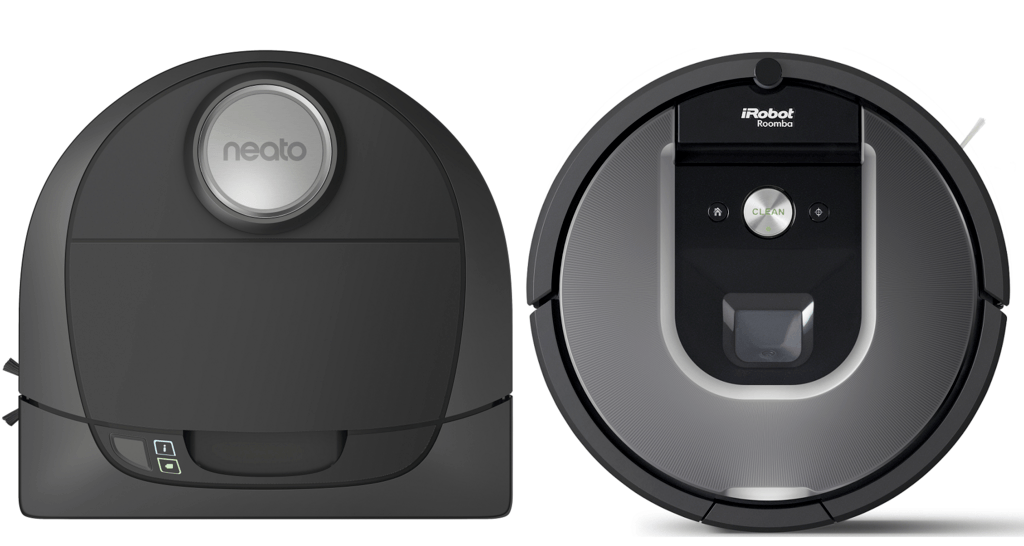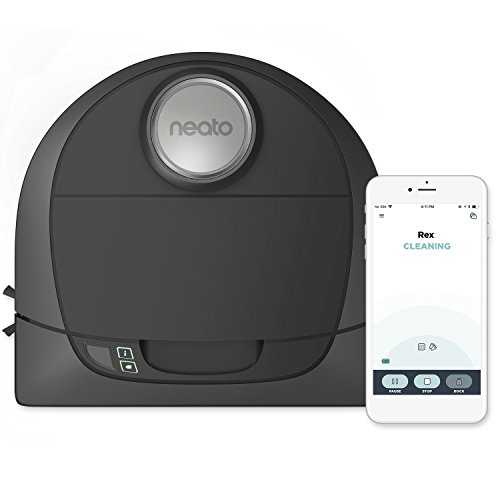In the land of robotic vacuums, the Roomba models generally take the top billing. More and more competitors are trying to add features and abilities while keeping the prices down. It seems that certain match ups could be swayed away from the champion. Is this such a case?
The Neato Botvac D5 Connected, besides being a mouthful of a name, is a competitor that could rival the Roomba 960. With features and options that are very similar, the prices and small differences are what matters the most.
In this article, we will examine the two machines and find out which one is the top prospect. If you are short on time and just want the winner: it’s the Roomba 960. Read on to find out why.
Contents
The Differences
When buying a robot vacuum, you may need a certain feature. That feature may be the difference maker in your decision. Let’s see where these two differ.
- The Neato uses laser-guided navigation where the Roomba uses camera-based navigation.
- The Roomba has a smaller battery and shorter runtime than the Botvac
- The 960 uses virtual wall barriers for containment; the D5 Connected has the magnetic tape.
- The Neato Botvac uses a combination brush roll for extraction; the Roomba 960 uses tangle-free brushless extractors.
The Similarities
The two robots are alike in a lot of ways. The most important similarities are listed for you here.
- The both use mobile apps and voice commands for control and programming.
- You can create and edit schedules for each model.
- Both offer HEPA quality (though not certified) filtration.
- Each model has improved suction over previous models in their respective lines.
- Larger collection bins and less maintenance were prominent design features for each vacuum.
- The two robots will automatically recharge dying batteries and resume cleaning when the batteries are fully charged.
Specifications Chart
Allow me to show you, side by side, the two robots so you can get an idea of how they stack up against each other.
| Roomba 960 | Neato Botvac D5 Connected | |
| Dimensions | 13.8×13.8×3.6 inches | 12.6×13.2×3.9 inches |
| Weight | 8.6 pounds | 7.5 pounds |
| Battery | 2600mAh Lithium-ion | 3600mAh Lithium-ion |
| Automatic Recharge | Yes | Yes |
| Automatic Resume | Yes | Yes |
| Runtime | Up to 75 minutes | Up to 120 minutes |
| Recharge Time | 3 hours | 4 hours |
| Filter | AeroForce high-efficiency | Neato Ultra |
| Collection Bin Capacity | 0.5L | 0.5L |
| Wireless Communications | Yes | Yes |
| Bluetooth | No | No |
| Remote Control | Yes (separate purchase) | No |
| Mobile App | Yes | Yes |
| Voice Commands | Yes | Yes |
| Local Controls | Yes | Yes |
| Navigation | IAdapt 2.0 Navigation Technology | LaserSmart Technology |
| Mapping | Visual Sensor Based | LaserSmart Mapping |
| Drop Sensors | Yes | Yes |
| Bump Sensors | Yes | Yes |
| Dirt Detection Sensors | Yes | No |
| Visual Camera Sensors | Yes | No |
| Laser Sensors | No | Yes |
| Containment | Virtual Wall Barrier | Magnetic Tape |
| Scheduling | Yes | Yes |
| Full Bin Indicator | No | No |
| Side Brushes | 1 | 1 |
| Floor Types | All | All |
| Warranty | 1 year | 1 year |
| Price | Check on Amazon | Check on Amazon |
Dimensions, Features and Options
Now it’s time to get down to brass tacks (or have the robot pick them up for you. Let’s pit the two robots against each other and see how they really compare.
Batteries need to power a lot of features
Robots run on batteries, that is no secret. What you may not realize, though, is that to save money, some robots have batteries that are just too small. We almost see that here in the Roomba 960, almost.
The 960 ships with a 2600mAh battery. At least the original models did. iRobot has discontinued their 2600mAh battery packs and now only offer the 1800mAh battery for the 960. When fully charged you will get about an hour of runtime before the robot decides it needs to return to the charging station for a few hours.
During that time you will be able to cover about 1600 square feet of hard flooring surface. Some users report they get a little more (up to 1800 square feet). However, if you toss in some carpet, that number drops to about 1200 square feet.
This may not seem like a big deal, and in fact, it isn’t. The Roomba will recharge the batteries and resume cleaning where it left off if the job isn’t complete. The automatic resume is a great feature to overcome a small battery.
The Neato D5 Connected also resumes automatically after recharging the battery. It takes longer to charge, though, by about an hour over the Roomba. This is because the battery is near twice the size.
The Neato comes with a 3300mAh battery pack that will drive the robot for nearly two hours. This is enough to easily clean 1800 square feet of mixed carpet and hard flooring in a single charge.
Bottom Line: The Neato D5 Connected wins. The larger battery and longer runtime stand out.
Containment Shouldn’t Be a Hassle
There are times when we don’t want our robot vacuums to have access to the entire home. There can be an unlimited number of reasons for this, but most commonly we block off specific rooms or parts of rooms.
We may not want the robots to get near the pet food bowls, or we have potted plants on the floor. During holidays we may have floor decorations that don’t need to be vacuumed. Whatever the reason, containment is essential.
The D5 Connected uses magnetic tape as a containment method. You will receive a 9-foot roll with your purchase. When you want to block off an area you have to measure the space, unroll and cut the tape to size and secure it to the floor, flat side down.
You can use tape to secure the magnetic strip to the floor or some other method. Tape on the carpet may be difficult though.
Once in place, the magnetic field will prevent the robot from crossing over, which is effective, though cumbersome. Not only do you have to measure and cut and place, but after the cleaning cycle, you have to remove and store it.
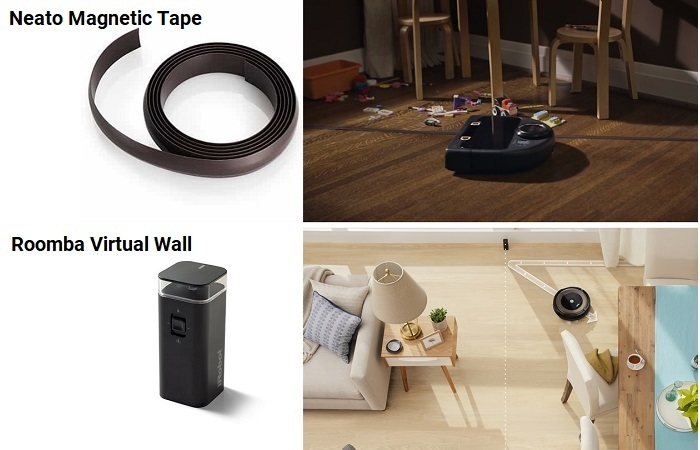
The Roomba, on the other hand, uses virtual wall barriers. These little towers run on batteries (included) and send out an infrared beam. In linear mode, it will send out a bean in a straight line up to 10 feet. This mode is useful for blocking off doorways or hallways.
When the robot sensors detect the beam, it treats it like a physical barrier such as a wall. The robot will get as close to the beam as it can before changing direction.
You can also switch the tower to halo mode. This will send out a ring about 4 feet in diameter with the tower in the center. This is useful to protect the dog’s water bowl or that floor lamp in the corner of the living room.
You don’t need to measure or cut anything and after the cleaning cycle is complete, you just turn the switch off and store the tower away.
Bottom Line: The Roomba 960 wins. Infrared containment is superior and easier to use than magnetic containment.
You probably remember your mom making you vacuum the house. She would come behind and check your work, making sure the lines in the carpet were uniform and you didn’t miss any spots. Maybe that was just my mom.
Regardless, human-like navigation ensures that every inch of your flooring gets cleaned. Few models accomplish this task as most use a sporadic and pseudo-random cleaning pattern. The 960 and D5 Connected have navigation and mapping technology that allows them to clean in parallel lines, ensuring all corners of your home are covered.
The Roomba 960 uses a bevy of sensors to navigate and map your home. Drop sensors prevent the robot from falling down stairs or getting caught on ledges that are higher than about half an inch.
The bump sensors are a mix of infrared and acoustic sensors that alert the robot to a solid object or obstacle is coming up. There are even dirt detection sensors that tell the robot the area is still dirty and needs to be cleaned further.
What is important here though, is the iAdapt 2.0 technology. This technology uses an onboard camera to create a three-dimensional map of your floor plan. It also detects obstacles, such as furniture legs, so the robot avoids collisions.
The camera constantly updates the map with new images and the images are stored in the memory of the robot. By constantly checking the created map the robot will know where it is in your home, where it has been and where it has left to clean.
Similarly, the D5 Connected also uses sensors to navigate and map your home. It also has the bump sensors to prevent running into walls and furniture at higher speeds. It also has drop sensors to keep it from taking a plunge down your stairs.
There aren’t dirt detection sensors though, but it does know when it is on a carpet and boosts the motor speed to help collect debris from the carpet fibers.
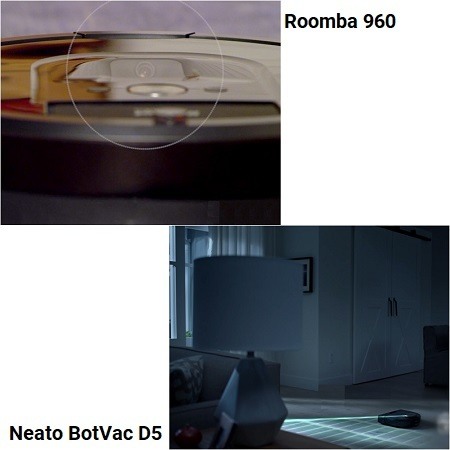
Instead of camera-based mapping, the Neato uses lasers. What they term LaserSmart technology is a method of using the ceiling to know the location of the robot and map your home. The lasers scan the ceiling for corners and landmarks like ceiling fans and lights.
Once the map is created the other sensors navigate the robot around the room. The map is stored in the memory of the robot and updated often. Furniture, obstacles and other objects are also noted for their location to help the robot appear to learn your layout and adjust its movements accordingly.
Bottom Line: This round is a tie. Camera and laser navigation work just as well as one another, so it is a personal preference.
The Controls Need to be Robust and User-Friendly
Control options are actually highly important. What once started as local controls only or infrared remote control, has turned into mobile apps and voice commands.
These two models are no different. The local controls are still there, though they aren’t as robust as they used to be years ago. For the Roomba you have three local buttons that will perform a spot clean, send the robot the charging dock or do a full clean using the automatic cleaning mode.
The Neato Botvac is no different. The local controls have been stripped to the bare minimum in place of more robust, wireless control options.
Each robot also has voice commands. Using an Amazon Alexa or Google Home device you can use your voice to tell the robots to start or stop a cleaning cycle. You can even find out where the robots are, what their status is and send them back to the charging dock if needed.
The bulk of your programming and controls, though, will come through the use of the respective mobile apps.
The Roomba mobile app is one of the most robust and features rich on the market. It is one of the highest rated and has the least amount of issues. Everything on the app just works. You can start, stop, pause, resume or cancel a cleaning cycle. You can send the robot to the charging station; You can create and edit schedules for cleaning at times when it best suits you.
You can also get status updates on the progress, battery life and filter of the 960. Further, you can even give a name to the robot for use with the voice commands. The app is easy to use is quite intuitive.
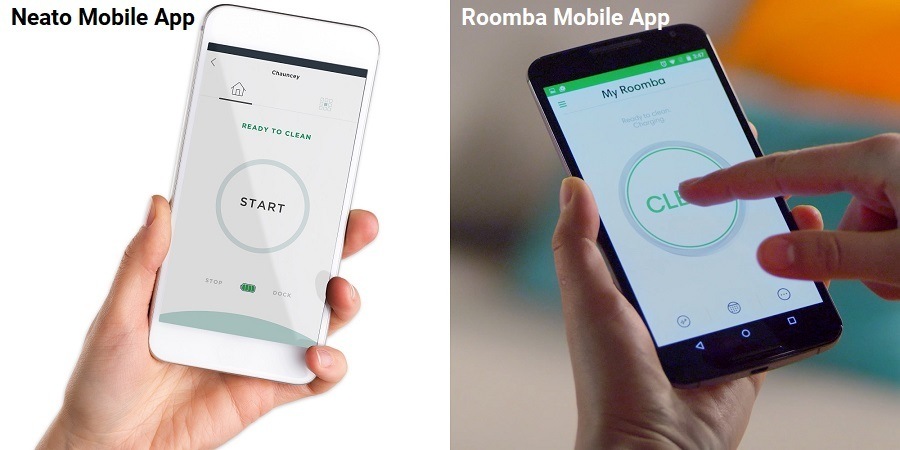
The Neato mobile app is also intuitive and user-friendly. It can do the same things that the Roomba app can, and just as easily. However, there are a lot of reported issues with the way it works, or, doesn’t work.
For instance, if you move the robot to a different level of your home, you will either need to purchase and sync a second charging station or clean the mapping from memory. The robot won’t be able to use the map from the app and it will get too confused trying to overwrite what is already there.
One of the biggest problems, though, is that the mobile app doesn’t always connect to the wireless network or drops connectivity while being used. The robot itself will also drop sync with the mobile app causing you to have to basically start over with the setup.
Bottom Line: The Roomba 960 wins this round. While the controls are near identical, the Roomba app is better and more reliable.
Filtration and Extraction Methods are Key
Allergies are a problem for a lot of us. Pet dander, pollen, dust mites, the list goes on. Having a vacuum with a filter that can capture these allergens is crucial for those that suffer from allergies.
The Roomba 960 uses what they call a high-efficiency filter. Meanwhile, the Neato D5 Connected uses the Neato Ultra. Both of these filters are top of the line and are equivalent to the HEPA certified filters.
In days past both Neato and Roomba received the certifications from HEPA for their filters. The only thing that has changed is that the filters no longer go through the certification process. They are the same filters though.
Both will collect particles down to 3 microns in size which includes up to 99.9 percent of all in-home allergens.
The extraction methods are where the two robots differ. The Roomba960 uses a tangle-free dual extraction bar set up. The two bars have rubber blades that lift, separate and untangle debris. They also agitate carpet fibers to loosen and lift dirt and dust from deep in the carpet.
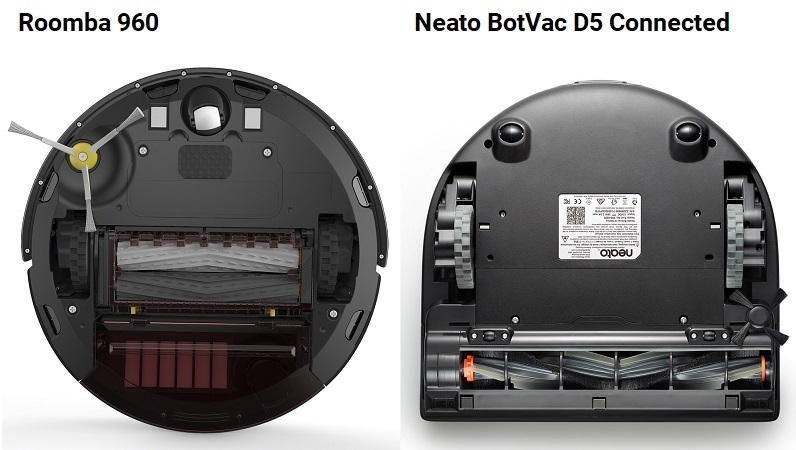
When iRobot says “tangle-free” they don’t mean that strings and hair and such won’t get wrapped around the bars. What it means is that it won’t tangle to the point you need pliers and scissors to remove them. Just pop the bars out and wipe them down and all the build-up wrapped around them slides right off.
The Neato Botvac D5, on the other hand, has a combination brush roll. It is a single roll with rubber blades for sweeping hard floors and stiff bristle brushes for agitating carpet fibers to loosen and lift dirt and debris.
The one thing you really need to pay attention to with the combo brush roll is on soft flooring surfaces. These include softwoods like pine, and floors that have a clear sealant on them like natural stone. The stiff bristles can scratch these surfaces. You will need to test this in a small area first and keep an eye on how long the robot is on these floor types.
Bottom Line: The Roomba 960 wins. While the filtration is a tie, the tangle-free brushless extractors are the best on the market.
Frequently Asked Questions
Let me answer a few of the most prominent questions that come up with these two models. If you still have a question or concern, feel free to use the comment section below.
Q. Do I need WiFi to control the robot?
A. No. If your wireless network goes down, or you otherwise don’t want to use the wireless connectivity, you can still control your robots through their local controls.
You should note, however, that this means you will not be able to use the mobile apps or the voice commands, create schedules or get status information.
Q. How often should maintenance be performed?
A. Both the Roomba 960 and Neato Botvac D5 Connected will need routine maintenance. This includes emptying the collection bin, which should be done after every cleaning cycle, or as the debris become less and less at least every second or third cleaning cycle.
You should also wipe the sensors clean weekly, check the extractor bars for tangles, wrapped hair or string and clean out any debris or build-up in the air duct. The filters should also be checked and brushed off at least weekly, replacing them with new ones every three to six months, depending on use.
What I Like About the Roomba 960
- HEPA quality filtration to reduce allergens.
- Tangle-free extractors for easy maintenance and use on all floor types.
- The best mobile app in the game.
What I Like About the Neato Botvac D5 Connected
- Laser guided navigation and sensor-based mapping work well.
- A large collection bin for less frequent emptying.
- Large battery for extended cleaning times.
In Conclusion
Both the Roomba 960 and the Neato D5 Connected have virtually every feature you need. From high-quality filtration to easy maintenance, you really can’t go wrong with either option.
The Neato has some flaws in the mobile app and the combination brush roll isn’t ideal for every floor type. However, aside from these two features that will only affect a small percentage of users, the robot does its job very well.
The Roomba, though, is nearly flawless. While it isn’t the top of the line in the Roomba arsenal, it has everything you need, including access to the best mobile app for robot vacuums on the market. Everything with the robot just works. I only wish it had a larger battery.
